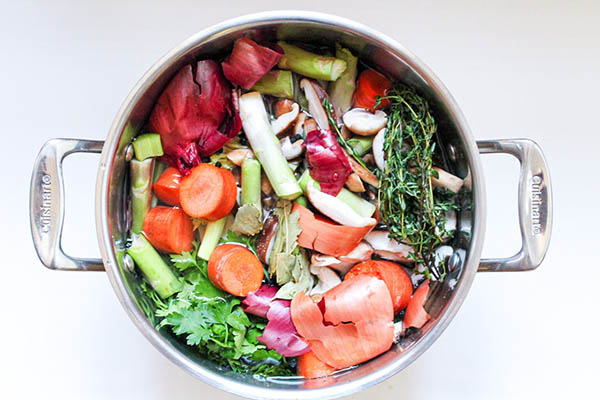
Making vegetable broth is popular these days, especially among health-conscious folks and that’s because when made with the quality ingredients vegetable broth can help reduce inflammation, boost the immune system and heal the gut. ⠀⠀⠀⠀⠀⠀⠀⠀⠀
Here’s a simple recipe for a delicious vegetable broth you can make using veggie scraps and other vitamin-rich ingredients. ⠀⠀⠀⠀⠀⠀⠀⠀⠀
Ingredients:
Leftover veggies scraps like carrots, celery, and onions (including the peel) are essential for making a good broth. ⠀⠀⠀⠀⠀⠀⠀⠀⠀
Other veggies that work and give it lots of flavors:
Leeks, white and pale green parts only
Garlic cloves smashed
Spring thyme
Bay leaves
Mushrooms
Bell peppers
Whole peppercorns ⠀⠀⠀⠀⠀⠀⠀⠀⠀
Note: The only veggies I don’t recommend adding to the broth are broccoli, cauliflower, and brussel sprouts – they will give the broth a bitter taste. Also, potatoes because they can make the broth cloudy and not as flavorful. ⠀⠀⠀⠀⠀⠀⠀⠀⠀
To season:
1 teaspoon of turmeric
Salt and pepper to taste
⠀⠀⠀⠀⠀⠀⠀⠀⠀
Instructions:
Add 12-15 cups of water in a large pot and place over high heat. Add all the vegetables in the water and stir. Bring to a boil, then reduce to a simmer for 1 hour. Remove from heat and allow to cool. Select the containers you’ll be storing broth in (I like clear large glass jars). Place a strainer (a cheesecloth works too) over the mouth of the jar and carefully pour the broth into jars. Store in the fridge for up to a week or freeze in ice cube trays for longer.
Versión En Español
Hacer su propio caldo de verduras esta muy de moda, especialmente entre las personas conscientes de la salud y eso se debe a que cuando se hace con ingredientes de calidad, el caldo de verduras puede ayudar a reducir la inflamación, estimular nuestro sistema inmunológico y sanar el intestino.
⠀⠀⠀⠀⠀⠀⠀⠀⠀
Aquí les dejo receta simple para un rico caldo de verduras que puedes hacer usando sobras de vegetales y otros ingredientes ricos en vitaminas.
Ingredientes:
Los restos de verduras como zanahorias, apio y cebolla (incluida la cáscara) son esenciales para hacer un buen caldo.
Otras verduras que funcionan y le dan mucho sabor:
Puerros, solo partes blancas y verde pálido
Dientes de ajo, aplastados
Tomillo de primavera
hojas de laurel
Hongos
Pimientos
Granos de pimienta enteros
Nota: Las únicas verduras que no recomiendo agregar al caldo son el brócoli, la coliflor y las coles de Bruselas; darán al caldo un sabor amargo. Además, las papas porque pueden hacer que el caldo se vuelva turbio y no tan sabroso.
Para sazonar:
1 cucharadita de cúrcuma
Sal y pimienta para probar
Instrucciones:
Agregue 12-15 tazas de agua en una olla grande y colóquela a fuego alto. Agregue todos los vegetales en el agua y revuelva. Caudno hirva el agua, baje a fuego lento durante 1 hora. Retirar del fuego y dejar enfriar.
Seleccione los recipientes en los que almacenará el caldo.
Coloque un colador (un paño de queso también funciona) sobre la boca del frasco y heche cuidadosamente el caldo en frascos. Almacene en el refrigerador por una semana o congele en bandejas de cubitos de hielo por más tiempo.
